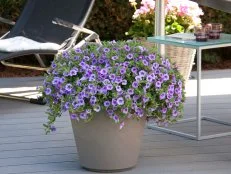How to Grow and Care for Celosia Plants
They’re bright, beautiful and can withstand even the hottest of summers. Start growing one of the best drought-tolerant flowers out there with these growing tips.

Celosia is the resilient, drought-tolerant annual you’ve been looking for. Gardeners rely on it summer after summer, knowing it can withstand the toughest of heat and drought. Plus, it has a unique look with spiky, feathery blooms. It also comes in a rainbow of colors, giving you great options for planting it in containers, along borders or any other space you want to brighten up.
.jpg.rend.hgtvcom.616.411.85.suffix/1716908436155.webp)
Wirestock Creators
Types of Celosia
Celosia comes from a large family under the botanical name, Celosia argentea. They all share similar appearance traits of upright, feathery flowers. Within this botanical name, there are three varieties of celosia to look for. They include:
Celosia plumosa
This one, also known as plume celosia, features soft, fluffy plumes that look like they're out of a whimsical fairytale.
Celosia cristata
Gardeners often refer to it as cock's comb celosia. Its blooms resemble a rooster's comb — wavy, quirky -- and definitely stands out in the garden.
Celosia spicata
This spiked celosia has bottlebrush-like flowers that are tall and proud, making them perfect backdrops for any floral setting.

Kurt Reynolds, Proven Winners
The flowing spikes of Celosia plumosa make a wonderful addition to cutting gardens and are a welcome addition to any floral arrangement.
Popular Varieties + Colors
Celosia is bold and colorful, available in shades of red, orange, yellow, pink and purple. They are a flower you can count on to stay bright all season long. Here are a few specific varieties to look for:
‘Flamingo Feather’: This variety of Celosia spicata is elegant and understated with soft pink and white flowers that resemble — wait for it — the feathers of a flamingo. It's perfect for adding a touch of whimsy to any garden spot.
‘Kurume’ Series: A bold collection from the Celosia plumosa group, these come in eye-popping colors like bright yellow, fiery orange and intense red. Their fluffy plumes make them great for both gardens and floral arrangements.
‘Dragon’s Breath’: If you’re looking to add some drama, this Celosia plumosa variety is perfect. With deep red leaves and vibrant red plumes, it’s a showstopper you can count on to hold up to summer heat.
‘King Coral’: This Celosia cristata variety is the plant that looks like a brain or coral.

Proven Winners
Celosia cristata is known for its vivid color and soft texture but is often called the flower that looks like a brain.
How to Use Celosia in Your Garden
There’s really not a wrong way to use celosia in your garden. It’s pretty much versatile enough to use in any setting. But here are some favorites.
Use celosia to add height and drama.
Taller varieties of celosia, like the spiky Celosia spicata or some larger Celosia plumosa, are perfect for adding height to your flower beds. Place them toward the back of your garden beds or in the center of island beds to create vertical interest.
Use celosia in containers.
Smaller, more compact varieties work wonders in containers. Mix them with your other favorite annual or let them stand alone as a fiery centerpiece on your patio or balcony. Their tolerance for heat makes them ideal for sunny spots.
Use celosia along borders.
Celosia's vivid colors and unique textures make them excellent border plants. Line walkways or edge garden beds with these showy flowers to define spaces with a dash of dazzle. They’re not just pretty — their dense growth can also help keep weeds at bay.
Use celosia to create a pollinator garden.
Celosia is a great plant for pollinators like bees, butterflies and other beneficial insects. If you’re trying to plant to benefit wildlife, then you definitely want celosia on your list.

Shana Feeley, Proven Winners
Vibrant and velvety, crested Celosia (Cockscomb) is a stunning addition to any garden.
Where to Plant Celosia
What’s the right location for planting celosia? Celosia loves the sun and requires a location that gets at least six hours of direct sunlight daily. They prefer well-draining soil, as soggy conditions can lead to root rot. An ideal spot would be one that's sunny and not super windy. If your garden tends to be on the dry side, no worries because once you establish celosia, it’s really drought tolerant.
Proper Soil Prep + Planting Techniques
Start by choosing a site with well-draining soil so they don’t get root rot. If your soil is heavy or clay-like, amend it with compost or peat moss to improve drainage. Otherwise, if planting in pots, start with a container mix, and you’ll be good to go.
Should You Start Celosia From Seed or Purchase Plants?
You can start celosia from seeds or buy annuals from your garden center. Plant celosia seeds or seedlings after the last frost, spacing them about 6 to 12 inches apart to ensure good air circulation. This will help prevent fungal diseases. With plants, gently loosen the root ball and set the plant at the same depth it was growing in its previous container. Water thoroughly after planting and add a layer of mulch to conserve moisture and keep weeds away.
How to Water, Fertilize + Mulch Celosia
Water your celosia plants deeply but infrequently, allowing the soil to dry out slightly between waterings to prevent root rot. They are light feeders, so a balanced, slow-release fertilizer applied at the beginning of the growing season is enough. Alternatively, you can use a diluted liquid fertilizer every 4-6 weeks during the growing season. To help retain soil moisture and control weeds, apply a thin layer of organic mulch around the base of the plants. This will keep roots cool and moist.
Easy Annual Plants That Bloom All Summer Long 16 Photos
Whether your garden is a large country plot or a group of containers on a city balcony, easy-to-grow annuals can add a burst of color wherever you need it.
Propagating Celosia
What’s the best way to propagate celosia?
It’s fun and easy to start celosia from seed. For the best results, start the seeds indoors about four to six weeks before the last expected frost. Lightly cover with a well-draining soil mix and keep it moist but not soggy. Seedlings should emerge within a couple of weeks. Once the danger of frost has passed and seedlings are strong, transplant them outdoors, spacing them several inches apart. Then thin later as needed. For a fun challenge, you can also try propagating celosia by cuttings. Just cut off a healthy stem, remove the lower leaves, dip in a rooting hormone, and place in water to encourage roots to form.
How do you save celosia seeds?
Wait until the flower heads are completely dry and have turned brown before harvesting. Carefully cut the flower heads from the plant and place them in a dry, well-ventilated area for a few more days to make sure they are thoroughly dried. Then gently rub the heads between your hands to release the seeds from the base of the old flowers. Collect and store seeds in a cool, dry place until it’s time to plant next spring.
.jpg.rend.hgtvcom.616.347.85.suffix/1716908436516.webp)
Celosia spicata is a prolific bloomer. It is easy to save its seeds and replant them next year.
Caring for Celosia Plants
Should you prune or deadhead celosia?
Pruning or deadheading celosia is beneficial for promoting fuller growth and extending the blooming period. Regularly remove faded or dead flowers to encourage the plant to produce more blooms. For bushier growth, you can also pinch back the tips of young plants early in the season.
How do you prevent and manage common pests and diseases?
To keep your celosia healthy and free from pests and diseases, start with prevention. Give your plants good air circulation by planting in a sunny, well-draining area and by spacing plants properly — 6-12 inches apart, depending on the variety. Water at the base to avoid wetting the foliage, which can lead to fungal diseases like powdery mildew. Regularly check for pests such as aphids and spider mites, especially under the leaves. If pests are found, treat the plants with insecticidal soap or neem oil. For fungal issues, removing affected parts and applying a fungicide can help manage the disease.
What’s the best way to have healthy and vibrant celosia plants?
For vibrant and healthy plants, make sure they receive at least six hours of sunlight each day in well-drained soil. Water deeply but infrequently and use a balanced fertilizer at the beginning of the season. Keep plants spaced apart to encourage good circulation and reduce disease. The final step is to regularly deadhead the spent blooms to encourage new flowers. By doing these things, you’ll be set to have gorgeous celosia every season.
















































